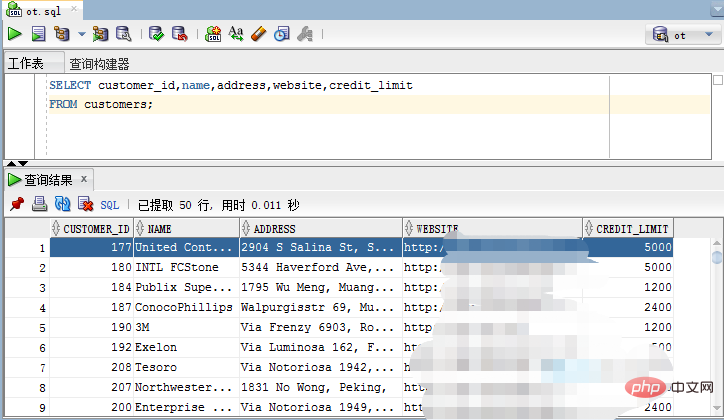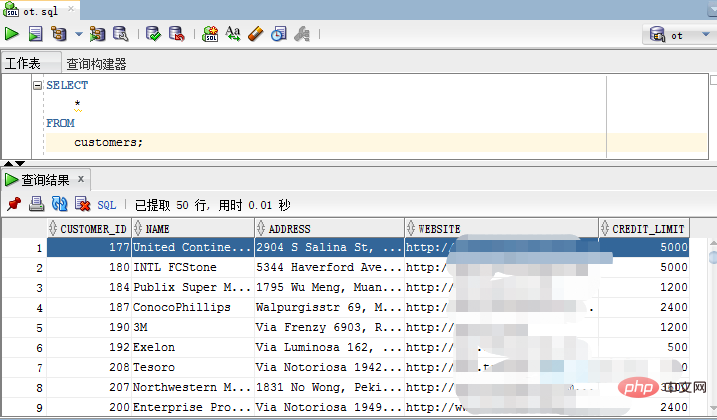How to query data of all fields in oracle
How to query all fields in oracle: 1. Use the "SELECT all field name list FROM data table name;" statement. Use English commas "," to separate multiple field names; 2. Use "SELECT * FROM Data table name;" statement.

The operating environment of this tutorial: Windows 7 system, Oracle 11g version, Dell G3 computer.
In Oracle, a table is composed of columns and rows. Data can be queried using the SELECT statement. Querying data refers to using different query methods to obtain different data from the database according to needs. It is the most frequently used and important operation.
To retrieve data from one or more columns (column_1, column_2,...,column_n) of a table, use a SELECT statement with the following syntax:
SELECT column_1, column_2, ... FROM table_name;
In this SELECT statement :
First, you need to specify the name of the table where the data is to be queried.
Secondly, specify the columns in which you want to return data. If you need to return multiple columns, you need to separate these columns with commas (
,).
oracle queries the data of all fields
Querying all fields refers to querying the data of all fields in the table. There are the following 2 ways to query all fields in the table.
Use the "
*" wildcard to query all fieldsList all fields of the table
Example:
For example, the customers table in the sample database has the following columns: customer_id, name, address, website and credit_limit. customersThere is also corresponding data in these columns in the table.

The following example will retrieve data in all columns of the customers table and list the names of all columns, as shown below:
SELECT
customer_id,
name,
address,
website,
credit_limit
FROM
customers;Execute the above example code , the following results are obtained -

#For convenience, to view all columns, you can use the abbreviation asterisk (*) to instruct Oracle to return data for all columns from the table, as shown below :
SELECT
*
FROM
customers;Execute the above example code and get the following results-

Please note that you can only use asterisks (*) test. In practice, even if you want to retrieve data from all columns of a table, you should explicitly specify the column from which you want to query the data.
This is because of business changes, the table may have more or fewer columns in the future. If you use asterisks (*) in your application code, it is assumed that the table has a fixed set of columns, but the application may not handle other unrelated columns or access deleted columns.
Recommended tutorial: "Oracle Tutorial"
The above is the detailed content of How to query data of all fields in oracle. For more information, please follow other related articles on the PHP Chinese website!

Hot AI Tools

Undresser.AI Undress
AI-powered app for creating realistic nude photos

AI Clothes Remover
Online AI tool for removing clothes from photos.

Undress AI Tool
Undress images for free

Clothoff.io
AI clothes remover

AI Hentai Generator
Generate AI Hentai for free.

Hot Article

Hot Tools

Notepad++7.3.1
Easy-to-use and free code editor

SublimeText3 Chinese version
Chinese version, very easy to use

Zend Studio 13.0.1
Powerful PHP integrated development environment

Dreamweaver CS6
Visual web development tools

SublimeText3 Mac version
God-level code editing software (SublimeText3)

Hot Topics
 1376
1376
 52
52
 How to import oracle database
Apr 11, 2025 pm 08:06 PM
How to import oracle database
Apr 11, 2025 pm 08:06 PM
Data import method: 1. Use the SQLLoader utility: prepare data files, create control files, and run SQLLoader; 2. Use the IMP/EXP tool: export data, import data. Tip: 1. Recommended SQL*Loader for big data sets; 2. The target table should exist and the column definition matches; 3. After importing, data integrity needs to be verified.
 How to check tablespace size of oracle
Apr 11, 2025 pm 08:15 PM
How to check tablespace size of oracle
Apr 11, 2025 pm 08:15 PM
To query the Oracle tablespace size, follow the following steps: Determine the tablespace name by running the query: SELECT tablespace_name FROM dba_tablespaces; Query the tablespace size by running the query: SELECT sum(bytes) AS total_size, sum(bytes_free) AS available_space, sum(bytes) - sum(bytes_free) AS used_space FROM dba_data_files WHERE tablespace_
 How to create a table in oracle
Apr 11, 2025 pm 08:00 PM
How to create a table in oracle
Apr 11, 2025 pm 08:00 PM
Creating an Oracle table involves the following steps: Use the CREATE TABLE syntax to specify table names, column names, data types, constraints, and default values. The table name should be concise and descriptive, and should not exceed 30 characters. The column name should be descriptive, and the data type specifies the data type stored in the column. The NOT NULL constraint ensures that null values are not allowed in the column, and the DEFAULT clause specifies the default values for the column. PRIMARY KEY Constraints to identify the unique record of the table. FOREIGN KEY constraint specifies that the column in the table refers to the primary key in another table. See the creation of the sample table students, which contains primary keys, unique constraints, and default values.
 What to do if the oracle can't be opened
Apr 11, 2025 pm 10:06 PM
What to do if the oracle can't be opened
Apr 11, 2025 pm 10:06 PM
Solutions to Oracle cannot be opened include: 1. Start the database service; 2. Start the listener; 3. Check port conflicts; 4. Set environment variables correctly; 5. Make sure the firewall or antivirus software does not block the connection; 6. Check whether the server is closed; 7. Use RMAN to recover corrupt files; 8. Check whether the TNS service name is correct; 9. Check network connection; 10. Reinstall Oracle software.
 How to add table fields to oracle
Apr 11, 2025 pm 07:30 PM
How to add table fields to oracle
Apr 11, 2025 pm 07:30 PM
Use the ALTER TABLE statement, the specific syntax is as follows: ALTER TABLE table_name ADD column_name data_type [constraint-clause]. Where: table_name is the table name, column_name is the field name, data_type is the data type, and constraint-clause is an optional constraint. Example: ALTER TABLE employees ADD email VARCHAR2(100) Add an email field to the employees table.
 How to re-query oracle
Apr 11, 2025 pm 07:33 PM
How to re-query oracle
Apr 11, 2025 pm 07:33 PM
Oracle provides multiple deduplication query methods: The DISTINCT keyword returns a unique value for each column. The GROUP BY clause groups the results and returns a non-repetitive value for each group. The UNIQUE keyword is used to create an index containing only unique rows, and querying the index will automatically deduplicate. The ROW_NUMBER() function assigns unique numbers and filters out results that contain only line 1. The MIN() or MAX() function returns non-repetitive values of a numeric column. The INTERSECT operator returns the common values of the two result sets (no duplicates).
 How to uninstall Oracle installation failed
Apr 11, 2025 pm 08:24 PM
How to uninstall Oracle installation failed
Apr 11, 2025 pm 08:24 PM
Uninstall method for Oracle installation failure: Close Oracle service, delete Oracle program files and registry keys, uninstall Oracle environment variables, and restart the computer. If the uninstall fails, you can uninstall manually using the Oracle Universal Uninstall Tool.
 How to solve garbled code in oracle
Apr 11, 2025 pm 10:09 PM
How to solve garbled code in oracle
Apr 11, 2025 pm 10:09 PM
Oracle garbled problems can be solved by checking the database character set to ensure they match the data. Set the client character set to match the database. Convert data or modify column character sets to match database character sets. Use Unicode character sets and avoid multibyte character sets. Check that the language settings of the database and client are correct.




